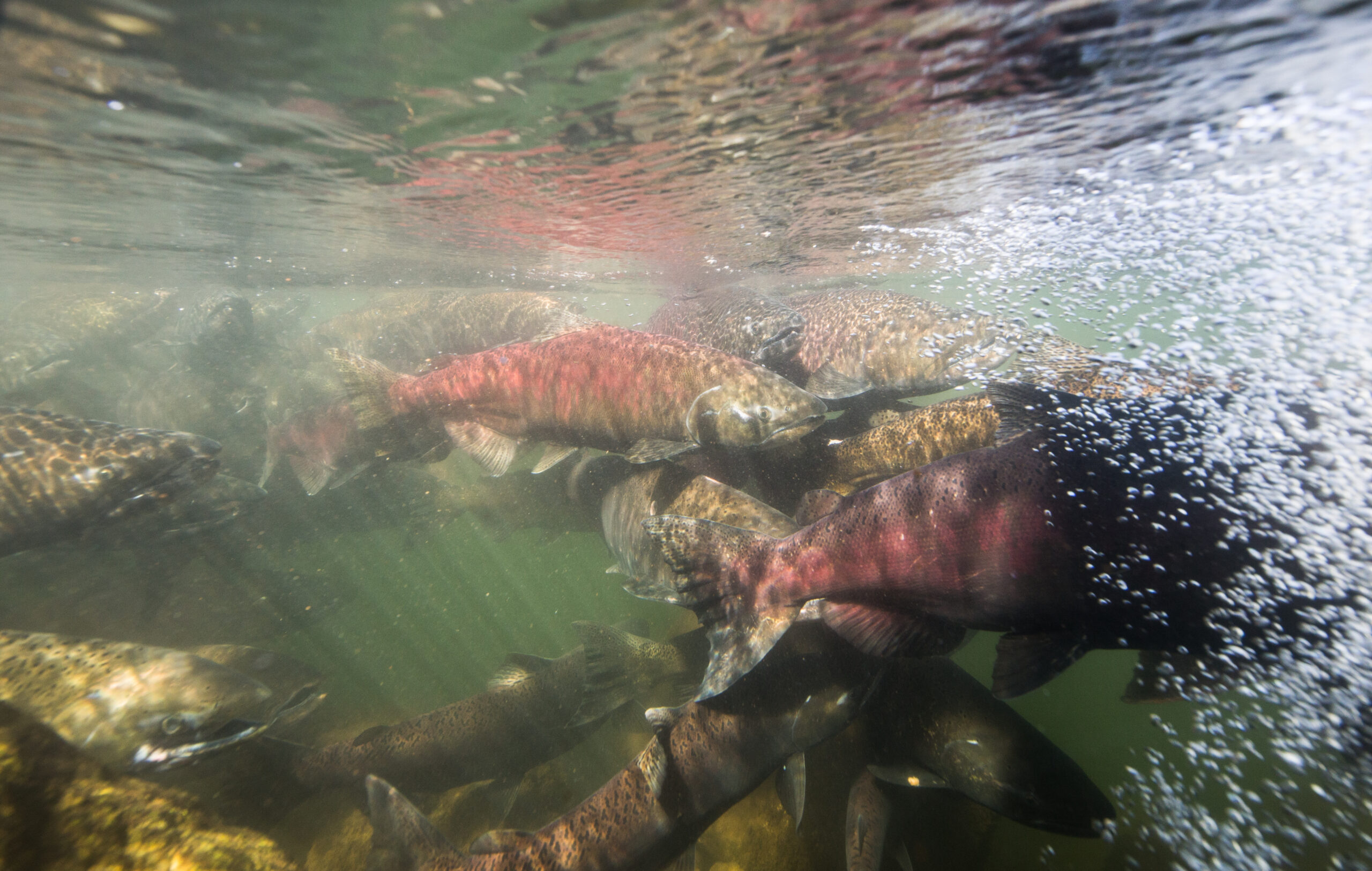
After two critically dry years that coincided with Trump-era rollbacks to environmental protections, some iconic Delta fish are closer than ever to the point of no return. Last fall, for the second year in a row, the fall midwater trawl found zero wild Delta smelt, while a coalition of environmentalists and fishermen is asking a federal court to help prevent a repeat of 2021’s near-obliteration of endangered winter-run Chinook salmon. Their lawsuit is just one of the balls to watch this spring as several projects and processes that could radically affect how much water flows through the Delta, and when, percolate.
“There’s a lot going on right now, kind of bubbling just below the surface,” says the Natural Resource Defense Council attorney Doug Obegi. NRDC is one of the parties to the lawsuit seeking to ensure that State Water Project and Central Valley Project operations protect salmon and other species. Last year, the projects released water from Lake Shasta early in the year, and did not leave enough cold water behind Shasta Dam to maintain cool water temperatures in the Sacramento River Basin during the winter-run spawning season.
“The spawning grounds overheated, just exactly as predicted,” says John McManus, president of the Golden State Salmon Association (GSSA), which advocates on behalf of fishermen and others. Salmon require water temperatures below about 54 degrees Fahrenheit for successful spawning, but river temperatures exceeded that level by five degrees or more for several crucial months. Fisheries biologists estimate that only 2.6% of the roughly 31 million eggs laid hatched into fry that survived outward migration as far as Red Bluff; only 0.4% are expected to survive as far as the Delta. “The hot water conditions that took out the winter run undoubtedly also took out much of the natural fall-run spawn that we would be relying on to produce a future crop of fall-run fish,” McManus says, referring to the backbone of the state’s salmon fishing industry. There is evidence that high temperatures also led to poor survival of migrating spring-run salmon.

The carnage was made possible by new federal Biological Opinions — Endangered Species Act-required rules that govern water project operations — developed in 2019 under then-Interior Secretary and former Westlands Water District lobbyist David Bernhardt. The rules stripped away critical protections for salmon, smelt, and other species and allow for more pumping from the Central Valley Project. Subsequently, and to nobody’s surprise, evidence emerged that science had been suppressed and scientists silenced while the new rules were developed.
Both the State of California and the coalition of NGOs — including the Pacific Coast Federation of Fishermen’s Associations (PCFFA), GSSA, NRDC, the Bay Institute, and Defenders of Wildlife — filed suit to invalidate the 2019 Biological Opinions, and soon after President Biden took office, the new administration flagged them for review. But in the meantime, the Bureau of Reclamation has been operating under the Trump administration rules. In 2021, the Bureau “let too much water go,” says McManus. “They did cut back some water deliveries. But some senior water right holders still got quite a bit of water. And that water could have been used to keep salmon alive. But it wasn’t.”
Last fall, the Bureau of Reclamation announced a reinitiation of consultation on the Biological Opinions, which will result in new, presumably more protective rules by 2024. But what happens in the meantime may determine the fate of the winter-run Chinook and other imperiled species.
The state and federal governments have together proposed an Interim Operations Plan for the two water projects that PCFFA plaintiffs say does little to protect species. “It is very similar to the Trump administration’s biological opinions,” says Obegi. “They added some provisions regarding Shasta storage and water temperatures that are woefully inadequate to protect winter-run, or fall-run if this year is critically dry.”
Declining to comment on the litigation, Russ Callejo, the Bureau’s deputy regional director, says, “We’re going to continue … to coordinate with our state, federal, and local partner agencies, on measures that we can take this year, if it is dry … to explore scientifically based, as well as feasible, options to improve the health of our fishery. Those conversations are ongoing; they’re still very early stage.” He adds that a healthy fishery is important to the agencies running the water projects, as well as to the wildlife agencies: “A healthier fishery helps us to operate more flexibly.”
The plaintiffs have filed a motion for preliminary injunction requiring more protective operations in 2022. Although the Biden administration is not defending the 2019 Biological Opinions in court, a number of water districts have intervened in the litigation, arguing that until the new Opinions are developed, the 2019 rules should govern operations.
Beyond the immediate impact on salmon, the case could fundamentally reshape the way water is allocated in California. “Our proposed injunction would require the Central Valley Project and State Water Project to reduce their allocations to what’s needed for human health and safety, prohibiting water allocations for agricultural and commercial uses unless they ensure adequate water temperatures for spawning salmon and meet Delta water quality objectives,” says Obegi. A hearing was scheduled for February 11.
Obegi and others note that the federal rules would be much less central to species protection efforts if the State Water Resources Control Board were to complete and implement a long-delayed update to the Water Quality Control Plan for the Bay and Delta (Bay-Delta Plan) that would increase flows through the Delta. In 2018, as part of the update, the Board adopted instream flow objectives for the lower San Joaquin River and its tributaries (known as Phase One), calling for 30% to 50% of unimpaired flows, and released the framework of a similar plan for the Sacramento River and flows into and through the Delta (Phase Two). Those objectives have since been on hold while the Brown and Newsom administrations attempted to reach “voluntary agreements” with water users that permit lower instream flows in exchange for “non-flow” measures, such as habitat improvements, to meet environmental goals.
In December, the state Secretary of Resources and CalEPA notified water users that they were giving up on the voluntary agreements for tributaries to the San Joaquin and moving ahead with implementation of Phase One, updated flow standards for the Stanislaus, Tuolumne, and Merced rivers. The new standards would be implemented no sooner than the summer of 2023. No such announcement has been made regarding Phase Two, and no new agreements have been proposed since 2020. The delay irks advocates for fish.
“If we had a water quality control plan that actually protected fish and wildlife there wouldn’t be a need for Endangered Species Act protections,” says Obegi. “ESA protections were triggered because the agencies repeatedly concluded that the water quality standards were not adequate to prevent the operations of the state and federal water projects from driving species towards extinction.”
As tragic as it would be to lose one of California’s native fish, the stakes are even higher than saving a species from extinction. The outcome of these conflicts will directly affect water quality in the Delta.
“This isn’t a fish versus farm situation,” says Regina Chichizola of Save California Salmon, a grassroots organization working with tribal communities. “This is the water that millions of people rely on. The salmon are like the canary in the coal mine; if the salmon go extinct, because there’s not enough water, what does that mean for all the people that actually rely on that water for their drinking water supply?”
Two new massive water infrastructure projects threaten to put even more pressure on Delta water supplies. In November, the proponents of Sites Reservoir released revised environmental documents for public review and comment. The project, a privately owned — though publicly subsidized — off-stream storage facility near Willows, is strongly opposed by tribal and environmental groups. “The project as proposed would hammer migrating salmon and worsen conditions in the Delta,” says Obegi.

Elsewhere in the Delta, the Department of Water Resources (DWR) and the U.S. Army Corps of Engineers are preparing to release environmental documents for the latest manifestation of the long-argued-over Delta tunnel. Now called the Delta Conveyance Project, the facility would include new north Delta diversion intakes with a capacity of 6,000 cubic feet per second. DWR maintains that operating rules for the facility will include restrictions on the amount of Sacramento River flow that can be diverted. However, so far little is known about those rules, and there are still open questions about how the project will be paid for.
All of these court fights, negotiations, and planning efforts are taking place against the backdrop of another looming drought year. Although major storms last fall stirred some hope for a wet winter — and enticed DWR to increase its promised water deliveries from 0% to 15% of contracts — January was one of the driest on record and February doesn’t look much better. As climate change brings ever-more-frequent dry years, California needs to plan ahead if it is to have enough water for both people and fish. An updated Bay-Delta Plan is crucial, say Baykeeper’s Jon Rosenfield and others.
“An updated water quality control plan, based on the best available science, with standards that are appropriate to protect the public trust, would prepare water contractors for how much water is going to be available,” says Rosenfield, adding that the Board would also have to be prepared to enforce those standards, rather than waiving them during dry years as it often does. As for DWR and Reclamation, he says that rather than behaving as though dry years are anomalies, they “should always act as though next year is going to be a critically dry year.”
Top photo: Adult fall run Chinook salmon near hatchery on American River. Photo: Andrew Innerarity, DWR.
Previous Estuary Stories
